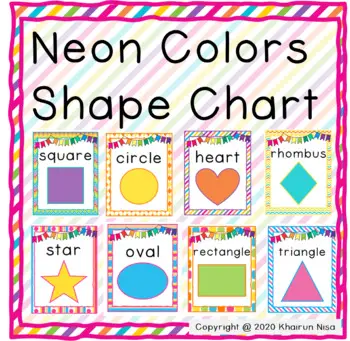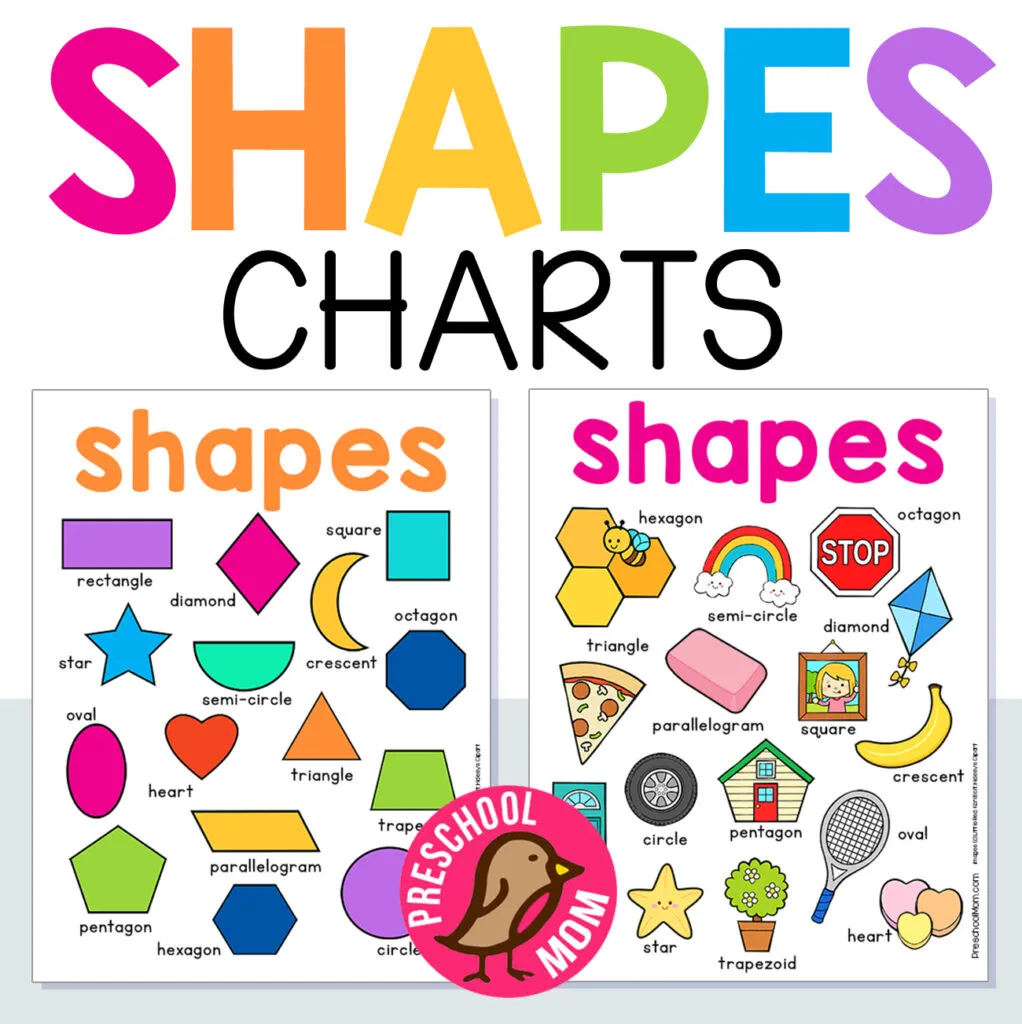Shapes provide visual information necessary for young people to understand their environment, and learning this concept does not need to be complicated.
Help children learn the shapes of objects around them using tools such as charts to make learning fun and engaging.
Here are nine shape charts to consider for young learners.
Great Shapes Chart for Preschoolers

This Basic 2D Shapes Chart includes six basic shapes that children need to learn. As they familiarize themselves with these shapes, they will learn to recognize objects with matching shapes around them.
This chart is downloadable from the site and is free. Each shape comes in a different color that looks like a small piece of artwork.
The colors show gradients and texture due to the color combination and the technique used to get the final look. The site even suggests different activities to make learning shapes fun.
Children will have fun playing the Shape Hunt Game, where they are given a shape based on the chart and are to find a matching object.
A challenging variation of this game is to have the children find an object with a matching shape and color based on the chart.
Another game, the Mystery Shape Bag, requires children to figure out the cut-out shapes inside a bag without looking. It is recommended that they wear a blindfold while putting their hand inside a dark-colored bag to identify the shapes inside.
For more information on this chart, go to LittleMultilingualMinds.com.

The neon colors stand out in this shape chart that can be downloaded from the site at no cost. This chart can be used to help children learn about shapes and colors in a visually appealing manner.
This bundle of posters comes with an eleven-page set and has eight shapes. Each shape has its chart. There is also a chart with all eight shapes together.
Place this chart in centers or use them individually during tabletop activities.
Use this chart as a reference when asking children to locate an object around them with an identical shape. Let children use the single-shape page as a mat to place objects with matching shapes.
Help children find the similarities and differences between the shapes on the charts and their outputs. Talk about the similarity in color or the difference in size.
If possible, laminate these posters or place them in transparent clear sheet protectors so children can use a dry-erase marker to trace the shapes.
For more information on this chart, go to TeachersPayTeachers.com.

This shape chart can double as an art piece for the classroom. The watercolor painting in each of the twelve shapes provides an eye-catching design for young children.
Combine learning shapes and art using this chart for children to make it exciting. Encourage children to create artwork with the same painting technique on cut-out papers with the same shapes on the chart.
Focus on one shape at a time to create artwork for the day. Vary the activity by having children use different colors of paint, layering or making several same shapes on paper with the same color, or having the same shape in various sizes.
Use the chart as a reference point when children cannot seem to know how to draw or make the shape.
Let them use their fingers to trace the poster, count the number of sides it has and identify unique features to remember better the shape’s name. Place the children’s output on display for everyone to see.
For more information on this chart, go to Etsy.com.

Here are anchor charts so extensive that there probably is no need to make extra ones. This comes in fifteen individual 2D shape charts that focus on a single shape at a time. All fifteen charts are free to download on the site.
The shapes include crescent, diamond, heart, hexagon, octagon, oval, parallelogram, pentagon, rhombus, semicircle, square, star, circle, trapezoid, triangle, and rectangle.
Each chart presents 2D illustrations of objects that have the same shape. For example, the crescent chart has bananas, jelly beans, a necklace, a moon, and a pepper.
The shape’s name is written on the top center part of the chart. While on the lower left side of the chart, an illustration of a child holding the corresponding shape can be seen.
These charts are excellent for discussions, finding real-life objects with the same shape, and learning about logical reasoning and categories through the “one odd out” activities.
Print two of the same chart for the latter suggestion and use one of the two as an anchor chart. Cut out the pictures on the second chart. Line up the pictures of identical shapes and add one picture with a different shape.
Help children identify the odd one by using the anchor chart to match the pictures and the shape.
For more information on this chart, go to PreschoolMom.com.

This pumpkin-themed shapes pocket chart combines shapes, shape-word identification, and sentence building in one. This 30-page bundle comes in colored and black and white.
The color version can be immediately used for the chart, while the students can customize the black and white by adding colors and designs.
There is a sentence strip that tells the shape. This strip goes with the shape’s name and is printed in a separate word strip and a small card with an illustration of the pumpkin. The adorable pumpkin comes in a different shape to complement the sentence strips.
This pocket chart is perfect to use for the fall theme. A small booklet about the shapes is included for children to read and practice to make learning shapes recognition even more fun.
Use the pocket chart during circle time to review and introduce new shapes. It can also be used to practice language and reading skills as they point at the words in the sentence strips.
Make it more challenging by letting children choose the correct pumpkin shape after reading the sentence strips. For more information on this chart, go to TeachersPayTeachers.com.

This pocket chart aims to help children struggling with identifying an object’s shape. Children will learn to organize pictures of things according to their shapes in the pocket chart.
The pictures will provide visual input on the shape of the object. Children may count its sides to determine its correct placement. This chart also comes with a worksheet for individual practice where children must match a picture with each shape.
The 2D Shapes Pocket Chart will provide plenty of practice opportunities. A single shape can be the lesson’s focus to help children become familiar with it.
Once they can fully identify the shape and the objects that go with it, the chart can come in handy as they are given two or more shapes simultaneously to sort.
Turn this sorting activity into a game by incorporating gross motor activities. Just place the picture cards on one end of the room and the chart on the other. Children will race to fill the rows.
Include a simple obstacle course between the cards and chart to make it more exciting.
For more information on this chart, go to TeachersPayTeachers.com.

This anchor chart is highly detailed as it explores not just the objects with the same color but also sides, vertices, and objects with similar shapes. The chart comes in color and black and white.
The site recommends different ways to use this material. It can be used for online classes in its pdf format, which the teacher can point to introduce the shapes to the students verbally.
There are also recommended printing options for this chart that can be used for different purposes. A large poster can be made by printing the page in an enlarged format.
Doing this will yield four pages that can be put together to make one big chart or used as a group activity sheet. For individual use, each part can be printed for children to put together during tabletop activities.
Use the build the chart option where the shapes and their features are in boxes that can be cut and glued together. This activity is a great way to review concepts or to use as a culminating activity for the shapes lesson.
For more information on this chart, go to TeachersPayTeachers.com.

This comprehensive chart has twenty different shapes for children to learn. It can be handy and tailored for children with varying skill levels, from the basic shapes to the more advanced ones.
The chart comes in a set that includes an anchor chart for all the twenty shapes, including the advanced shapes such as pentagon, hexagon, heptagon, octagon, nonagon, and decagon.
Another chart is a matching activity with the shape’s outline and name. The third chart is a shape-to-object picture guide to help children see the similarities.
The site recommends different engaging ways to use this chart. The first game is called Spot the Shape, where children survey their environment to find objects that match the shape on the chart.
The second game is Hunting Shapes, which is like a treasure hunt where children are given a list of objects corresponding to the shapes on the chart.
Children are also encouraged to color the shapes and to use magnetic tiles to make a specific shape based on the chart.
For more information on this chart, go to PlayOsmo.com.

As the name suggests, this chart introduces a new shape for children to learn each week. This resource has fourteen printable pages for math centers and tabletop activities.
There are twelve shapes that this chart addresses. In each one are pictures of five objects that have similar shapes. For example, the oval has pictures of candy, a mirror, an egg, a pool, and a perfume bottle.
Each of these pictures can be cut and used for a sorting activity intended for learners to recognize shapes in confidence.
Some shapes that may have added details, such as the gift box with bows on top, have an arrow pointing to the part where the child should focus. The arrow indicates the shape to be considered.
Try using this pocket chart during circle time, as well. It may be an excellent opportunity to discuss their favorite shapes or objects among the children based on the week’s shape.
Talk about each shape’s unique features, such as the circle and oval do not have sides, or other geometric shapes vary in the number of sides.
For more information on this chart, go to TeachersPayTeachers.com.
Conclusion
Teaching resources are an essential factor to consider when working with young children. Age-appropriate resources that promote learning based on their ability should be regarded at all times.
These shape charts are prime examples of what to use for young children to help them understand these concepts. The constant use of these resources in class will highly promote mastery of the different shapes. Thanks for stopping by! Hope to see you again soon.
For more helpful resources, check these out:






